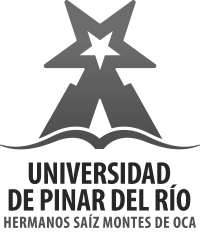Capacidad de carga trófica del venado de cola blanca (Odocoileus virginianus, Zimmermann, 1780)
Contenido principal del artículo
Resumen
La investigación se llevó a cabo en la localidad el Tibisí de la Empresa Agroforestal Minas de Matahambre, en 3 formaciones de pinares y bosque semideciduo, considerando las características del estrato arbóreo y arbustivo, durante la temporada poco lluviosa (menor producción de biomasa) de noviembre a abril y de mayo a octubre (máxima producción de biomasa). Una de las bases para el manejo adecuado de O. virginianus es determinar la capacidad de carga del hábitat, así como la composición botánica de la dieta de las especies de las cuales se alimenta. La densidad y cobertura de las especies arbóreas y la densidad de las especies arbustivas se evaluaron con el método de cuadrantes centrados en un punto; la cobertura de las especies arbustivas, con el método de parcelas de 4 x 4 m. y la producción de biomasa, con el método de Adelaide. La producción de biomasa de las especies utilizadas por el venado, en la temporada poco lluviosa, no presentó diferencia significativa entre tipos de vegetación, de acuerdo con la prueba de Tukey (α=0.05). Sin embargo, para la temporada de lluvias se encontró una diferencia significativa del bosque de galería con respecto al resto de las formaciones vegetales. Para la temporada de lluvias (183 días), la capacidad de carga que puede soportar el área es de 4,3 venados x ha., alimentándose de grupos de vegetales (árboles, arbustos y lianas), distribuidos en los cuatro tipos de bosques. Durante la temporada menos lluviosa, la materia seca disponible solo tolera 1,2 venados x ha.
Descargas
Detalles del artículo
Citas
ÁLVAREZ, P. A. Y J. C. VARONA, 2006. Silvicultura. Editorial Pueblo y Educación. 3ra. Edición- 354 p.
BARRERA SALAZAR, A., MANDUJANO, S., VILLARREAL, O. y JIMÉNEZ GARCÍA, D., 2015. Classification of vegetation types in the habitat of white-tailed deer in a location of the Tehuacán-Cuicatlán Biosphere Reserve, Mexico. Tropical Conservation Science, vol. 8, no. 2, pp. 547-563. ISSN 1940-0829.
GALLINA, S.A., MANDUJANO, S. y VILLARREAL, O., 2014. Monitoreo y manejo del venado cola blanca: conceptos y métodos. México: Instituto de Ecología. ISBN 978-607-7579-41-0.
GRANADOS, D., TARANGO, L., OLMOS, G., PALACIO, J., CLEMENTE, F. y MENDOZA, G., 2014. Dieta y disponibilidad de forraje del venado cola blanca Odocoileus virginianus thomasi (Artiodactyla: Cervidae) en un campo experimental de Campeche, México. Revista de Biología Tropical, vol. 62, no. 2, pp. 699-710. ISSN 0034-7744.
HERNÁNDEZ, F.R., 2010. Manejo de fauna cinegética. La Habana: Félix Varela. ISBN 978-959-07-1293-7.
LÓPEZ TÉLLEZ, C., MANDUJANO, S. y YÁNES, G., 2007. Evaluación poblacional del venado cola blanca en un bosque tropical seco de la Mixteca Poblana. Acta Zoológica Mexicana (nueva serie), vol. 23, no. 3, pp. 1-16. ISSN 2448-8445.
MANDUJANO, S., 2007. Carrying capacity and potential production of ungulates for human use in a Mexican tropical dry forest. Biotropica, vol. 39, no. 4, pp. 519-524. DOI https://doi.org/10.1111/j.1744-7429.2007.00305.x.
MARTÍNEZ POLANCO, M.F., 2011. La biología de la conservación aplicada a la zooarqueología. La sostenibilidad de la cacería del venado cola blanca, Odocoileus virginianus (Artiodactyla, Cervidae) en Aguazuque. Antípoda: Revista de Antropología y Arqueología, no. 13, pp. 99-118. ISSN 1900-5407.
MENDOZA, G., 2001. Alimentación de fauna en vida silvestre. Manual del Curso Taller Internacional sobre técnicas aplicadas a la conservación y manejo de fauna silvestre. México: Fish and Wildlife Service.
MORENO, J.C., 1991. Comportamiento alimenticio del venado cola blanca (Odocoileus virginianus miquihuanensis) en un matorral mediano subinerme en linares, Nuevo León. Trabajo de Diploma (no publicado). México: s.n.
PLATA, F.X., MENDOZA, G.D., VICCON, J.A., BÁRCENA, R. y CLEMENTE, F., 2011. Comparación de métodos basados en los requerimientos nutricionales y disponibilidad de biomasa para estimar la capacidad de carga para venado cola blanca. Archivos de Medicina Veterinaria, vol. 43, no. 1, pp. 41-50. ISSN 0301-732X. DOI http://dx.doi.org/10.4067/S0301-732X2011000100006.
REYES, G., 1989. Comparación de métodos indirectos para estimar la biomasa forrajera de diez especies arbustivas y arbóreas en un matorral de la región de linares N. L. Trabajo de Diploma (no publicado). México: s.n.
ROJAS PARDO, L.N., 2010. Evaluación del uso y calidad del hábitat en poblaciones del venado cola blanca Odocoileus virginianus en la Reserva Natural La Aurora, municipio de Hato Corozal, Casanare [en línea]. Trabajo de Diploma. Colombia: Pontificia Universidad Javeriana. Disponible en: https://repository.javeriana.edu.co/handle/10554/8484.
ROJAS, S., 2004. Capacidad de carga para venado cola blanca (Odocoileus virginianus ssp. mexicanus gmelin, 1788) en la estación forestal experimental Zoquiapan, estado de México. Trabajo de Diploma (no publicado). México: s.n.
SUTHERLAND, W.J., 2006. Ecological Census Techniques. A handbook. 2da. United Kingdom: Cambridge University Press.
VILLAREAL ESPINO, O.A., GUEVARA VIERA, R., FRANCO GUERRA, F.J., HERNÁNDEZ HERNÁNDEZ, J.E., ROMERO CASTAÑÓN, S. y BARRERA HERNÁNDEZ, T., 2008. Evaluación de las unidades de manejo para la conservación de la vida silvestre del venado cola blanca en la región Mixteca, México. Zootecnia Tropical [en línea], vol. 26, no. 3. ISSN 0798-7269. Disponible en: http://www.scielo.org.ve/scielo.php?pid=S0798-72692008000300053&script=sci_arttext.
VILLAREAL ESPINO, O.A., PLATA PÉREZ, F.X., CAMACHO RONQUILLO, J.C., HERNÁNDEZ HERNÁNDEZ, J.E., FRANCO GUERRA, F.J., AGUILAR ORTEGA, B. y MENDOZA MARTÍNEZ, G.D., 2011. El Venado Cola Blanca en la mixteca poblana. Therya, vol. 2, no. 2, pp. 11-25. ISSN 2007-3364. DOI http://dx.doi.org/10.12933/therya-11-25.
WEBER, M., GARCÍA MARMOLEJO, G. y REYNA HURTADO, R., 2006. The Tragedy of the Commons: Wildlife Management Units in Southeastern Mexico. Wildlife Society Bulletin, vol. 34, no. 5, pp. 1480-1488. DOI https://doi.org/10.2193/0091-7648(2006)34[1480:TTOTCW]2.0.CO;2.


